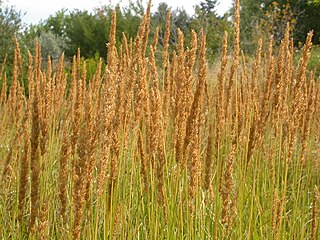
Calamagrostis stricta, known as slim-stem small reed grass or narrow small-reed, is a species of bunchgrass in the family Poaceae of the Holarctic Kingdom.
Melica argyrea is a species of grass found in Argentina, Brazil, and Uruguay.

Melica amethystina is a grass species in the family Poaceae that can be found in southern Europe.
Melica animarum is a species of grass that is endemic to Sierra de las Ánimas in Uruguay.
Melica tangutorum, is a species of grass found in China and Mongolia.

Melica teneriffae, is a grass species in the family Poaceae that is endemic to the Canary Islands.
Melica lilloi is a species of grass found in Catamarca and Tucumán provinces of Argentina at 3,200–3,500 metres (10,500–11,500 ft) above sea level.
Melica kozlovii is a species of grass found on mountain slopes in Mongolia and China at 2,000–3,900 metres (6,600–12,800 ft) above sea level.
Melica paulsenii is a species of grass endemic to Chile where it grows along the coastal cordillera at 50–700 metres (160–2,300 ft) above sea level.
Melica rigida is a species of grass found in Argentina, Brazil, and Uruguay.
Melica patagonica is a species of grass that is endemic to South America.
Melica radula is a species of grass endemic to China. It grows on grassy mountain slopes and larch forests at 300–1,200 metres (980–3,940 ft) above sea level.

Calamagrostis varia is a species of flowering plant from the family Poaceae which is native to Europe.

Agrostis vinealis is a species of grass known by the common names brown bentgrass and brown bent, which can be found from Russia to Mongolia, China, Pakistan, India and Alaska. It was introduced to Greenland and South Georgia and the South Sandwich Islands.

Agrostis humilis is a species of grass known by the common names of mountain bent grass and alpine bentgrass, which can be found in Western United States and Canada.

Calamagrostis villosa is a species of flowering plant from the family Poaceae which is native to Europe.
Festuca abyssinica is a species of grass which is endemic to Africa.
Agrostis thurberiana is a species of grass that is native to northwest and southwest United States and Canada.
Festuca actae is a species of grass which can be found in New Zealand.
Festuca polycolea is a species of grass which is endemic to India.






